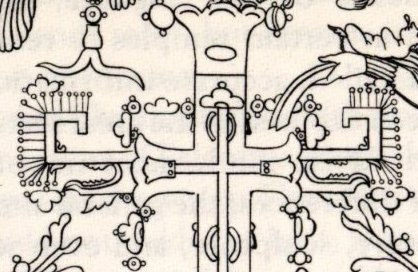|
6. I think there is a connection between Orion and the Egyptian X. Both include Betelgeuze and the overall outline is the same. In the Chinese sky Orion is drawn with the same type of 'stones' as in my hura glyph type (cfr at A Common Sign Language):  ... We must avoid being caught up in the enormous amount of details calling for attention in this Mayan version of the World Tree.
My intention was here only to show the existence of these 'rakau' signs outside of Easter Island. Obviously they are meant to be counted and, we should remember, 'tree' signs are necessary when counting: ... one sign, very common in the codices where it appears affixed to main signs, can be read as 'te' or 'che', 'tree' or 'wood', and as a numerical classifier in counts of periods of time, such as years, months, or days. In Yucatec, you cannot for instance say 'ox haab' for 'three years', but must say 'ox-te haab', 'three-te years'. In modern dictionaries 'te' also means 'tree', and this other meaning for the sign was confirmed when Thompson found it in compounds accompanying pictures of trees in the Dresden Codex ... The World Tree can take on many different shapes, but presumably it is astronomical in character, for instance serving as an image of the Milky Way, with the small circles ('bulbs') representing prominent stars important for the calendar makers. It is interesting to note the similarity with how the Chinese anciently represented the stars on their charts, viz. as small circles ... In the Chinese version of X (Orion) there is a star in the center, viz. 'the string of pearls', Alnilam (cfr at Parehe).
One day later than Alnilam both Alnitak and Phaet are rising at the same time in the day. This is another indication of my proposed connection between Orion and Egyptian X. 496 (= 62 * 8) at hura in Ha6-28 can be compared with how Sun in Ga1-23 evidently disappears into an 'unknown henua' outside the regular and enlightened cosmic order of time:
The following atariki is at Betelgeuze and then - once again precisely 1 day later - the triplet of stars Praja-pāti, Menkalinan, and Mahashim, are rising together. From Phaet to Naos there are 122 - (22 + 64) = 36 days:
Perhaps the name Egyptian X is a wordplay which alludes to the Egyptian calendar with 360 days, because it was divided into decans - periods with 10 days in each and therefore 36 such. |
||||||||||||||||||||||||||||||||||||||||||||||||||||||||||||||||||||||||||||||||||||





